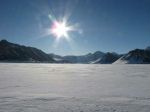
A basic equation in daytime visual range theory, relating the apparent luminance of a distant black object, the apparent luminance of the background sky above the horizon, and the extinction coefficient of the atmosphere, or the air layer near the ground. ...

